Martienssen W., Warlimont H. (Eds.). Handbook of Condensed Matter and Materials Data
Подождите немного. Документ загружается.

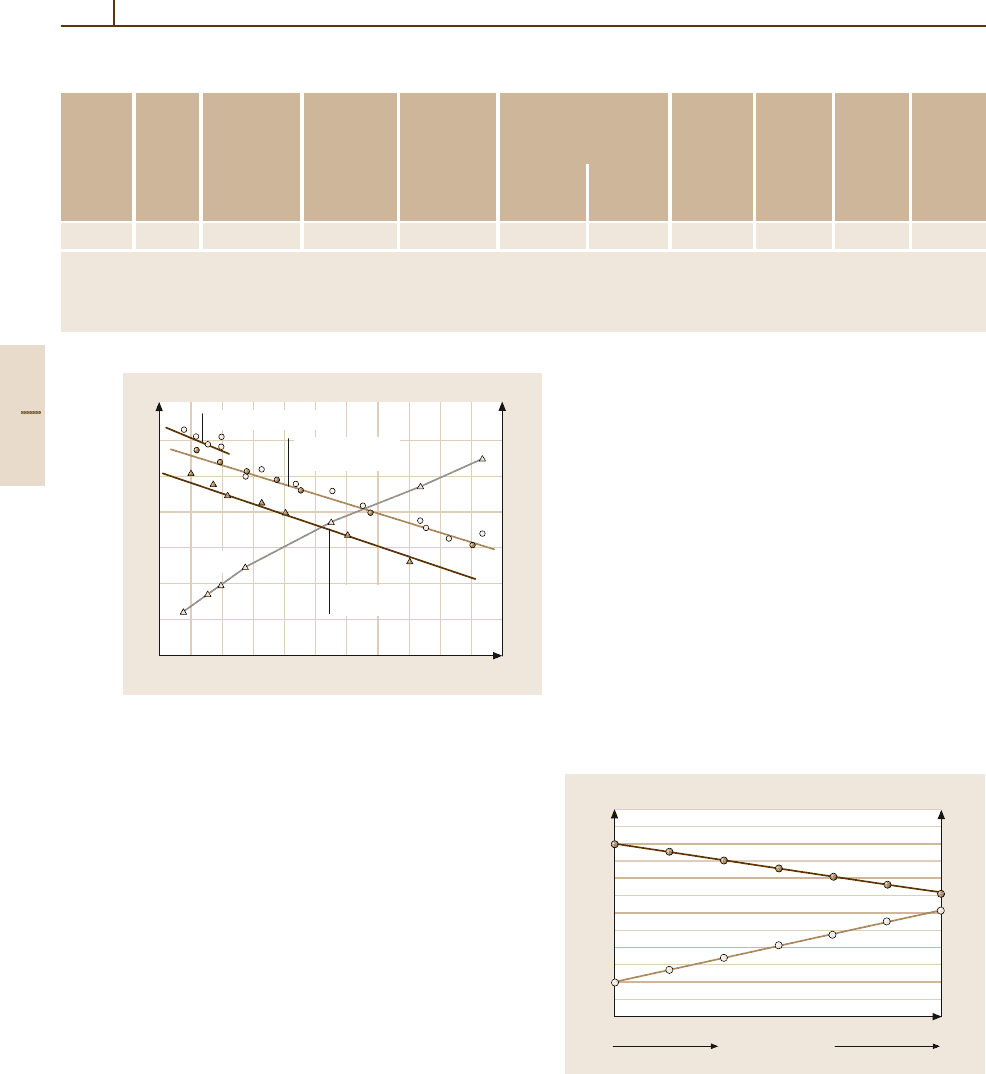
802 Part 4 Functional Materials
Table 4.3-40 Physical properties of sintered Nd
−
Fe
−
B magnets
a
Density Curie Electrical Specific Thermal Thermal expansion Young’s Flexural Com- Vickers
temp- resistivity heat conduc- coefficient modulus strength pression Hardness
erature tivity strength
-c axis ⊥-c axis
(g cm
−3
) (K) ( mm
2
m
−1
) (Jkg
−1
K
−1
) (Wm
−1
K
−1
) (10
−6
K
−1
) (10
−6
K
−1
) (kN mm
−2
) (N mm
−2
) (N mm
−2
)
7.5 (0.05) 580–605 1.50 (0.10) 430 (10) 9 4.4 (0.6) −1 155 (5) 260 (10) 930 (170) 580 (10)
a
All values are for 300 K. The values are the averages taken from the companies brochures of: VAC Vacuumschmelze, Hanau, Germany;
MS Magnetfabrik Schramberg, Schramberg, Germany; Ugimag Inc, Valparaiso, USA; Neorem Magnets Oy, Ulvila, Finland; TDK
Corporation, Tokyo, Japan; Hitachi Metals Ltd, Tokyo, Japan. The numbers in parentheses indicate the maximum deviation
1.4
1.2
1
0.8
240
160
80
0
800 1200 1600 2000 2400 2800
T
max
(°C)Br (Tesla)
H
c, j
(kA/M)
Isostatically pressed
Pressed in
transverse fields
Pressed in
axial fields
T
max
Fig. 4.3-61 Sintered Nd
−
Fe
−
B magnets. Possible combi-
nations of B
r
and
J
H
c
resented by a straight line, as shown in Fig. 4.3-61. The
physical properties of sintered Nd
−
Fe
−
B magnets are
given in Table 4.3-40.
Magnets Processed by the Rapid Quenching/Hot
Working Technique
This alternative technology uses isotropic or amorphous
material processed by a rapid quench technique involv-
ing melt spinning the molten alloy through a nozzle
on to a rotating wheel. Flakes that are about 30 µm
thick are obtained. Their microstructure shows typic-
ally an average grain size of 50 to 60 nm. The material is
subjected to controlled deformation at elevated tempera-
tures, which givesrise to a texture orientedperpendicular
to the direction of mass flow during deformation. Hot
working processes applied are the die-upset method
and indirect extrusion. The major steps of the process
are: alloy preparation, melt spinning, cold forming, hot
working, coating, and magnetizing. The first step of the
hot working procedure is pressing to 100% density at
temperatures between 700 and 800
◦
C. Isotropic mag-
nets are obtained. The isotropic parts are deformed at
about 800
◦
C by using the die-upset technique. Con-
stant strain rates have to be applied. Typically, the strain
rate is about 0.1sec
−1
. The strain rate and the degree
of deformation determine the alignment factor of the
final magnet. A maximum value for the magnetic re-
manence B
r
of about 1.35 T may be achieved under
economically reasonable conditions. The relationship
between the degree of deformation and B
r
is shown in
Fig. 4.3-62. Properties of commercially availabe mag-
nets are included in Table 4.3-41. The application of the
magnets is limited to special fields where complicated
shapes would otherwise require expensive machining
1800
1600
1400
1200
1000
800
600
1.8
1.6
1.4
1.2
1
0.8
0.6
Degree of deformation
Isotropic Anisotropic
H
c, j
(kA/m) Br (Tesla)
H
c, j
Br
Fig. 4.3-62 Dependence of remanence B
r
and coerciv-
ity
J
H
r
of dense magnets, manufactured by the hot
pressing/hot working technique, on the degree of defor-
mation. Data provided and authorized for publication by
Magnequench Int., Tübingen
Part 4 3.3
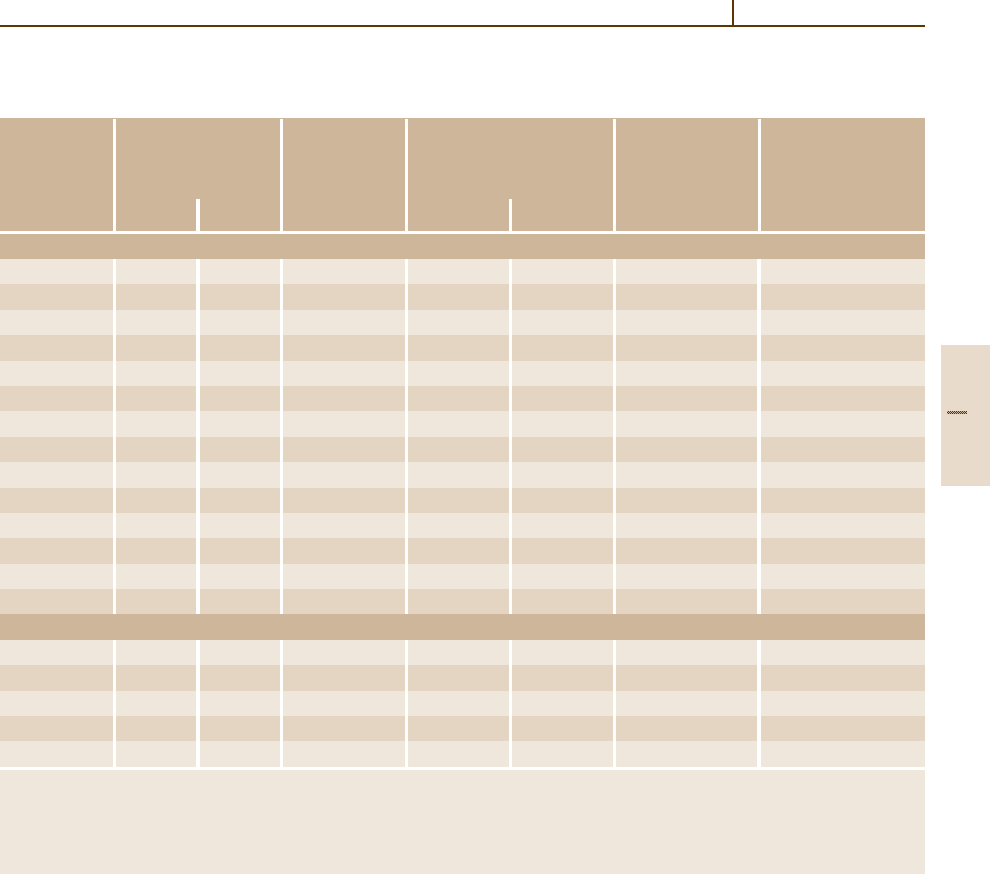
Magnetic Materials 3.3 Hard Magnetic Alloys 803
Table 4.3-41 Magnetic properties of Fe
14
Nd
2
B-based magnetic materials at room temperature. Typical values of commercially
available magnets
Remanence Coercivity Energy density Temperature coefficients Max. operation Product code
b
temperature
a
(T) (kA m
−1
) (kJ m
−3
) (% K
−1
) (
◦
C)
B
r B
H
c J
H
c
(BH)
max
TC(B
r
) TC(
J
H
c
) T
max
Sinter Route
1.47 915 955 415 −0.115 −0.77 50 VD722HR
1.44 1115 1195 400 −0.115 −0.73 70 VD745HR
1.35 1040 1430 350 −0.095 −0.65 110 VD633HR
1.30 980 1035 325 −0.115 −0.80 70 VD335HR
1.18 915 2465 270 −0.085 −0.55 190 VD677HR
1.43 915 9550 395 −0.115 −0.77 50 VD722TP
1.41 1090 1195 385 −0.115 −0.73 70 VD745TP
1.32 1020 1430 335 −0.095 −0.65 110 VD633TP
1.25 965 1195 300 −0.115 −0.75 70 VD335TP
1.14 885 2865 250 −0.080 −0.51 220 VD688TP
1.32 965 1115 335 −0.115 −0.73 80 VD510AP
1.26 965 1510 305 −0.095 −0.64 120 VD633AP
1.22 900 1195 285 −0.115 −0.75 80 VD335AP
1.08 830 2865 225 −0.080 −0.51 230 VD688AP
Hot Working
0.83 575 1400 120 −0.10 −0.50 180 MQ2-E15
1.28 907 995 302 −0.10 −0.60 125 MQ3-E38
1.25 915 1313 287 −0.09 −0.60 150 MQ3-F36
1.31 979 1274 334 −0.09 −0.60 150 MQ3-F42
1.16 876 1592 255 −0.09 −0.06 200 MQ3-G32SH
a
Maximum operating temperature is defined by a straight demagnetization line up to an operation point of the magnet of B/µ
0
H =−2
b
VD = Vacodym, trade name of Vacuumschmelze GmbH for NdFeB based magnets; HR grades = isostatically pressed, TP grades =
transverse field pressed, AP grades = axial field pressed. MQ2, MQ3 = trade names of Magnequench International Inc. for hot pressed - hot
deformed magnets
work, as for instance screwed arcs for non-cogging
motors.
Typical technical alloys and their properties are
listed in Table 4.3-41. Characteristic demagnetization
curves are shown in Fig. 4.3-63.
4.3.3.5 Co–Sm
Numerous magnetic, binary, rare earth (RE) transition
metal (TM) compounds exist, of which the Co
5
RE
and Co
17
RE
2
phases form the basis for materials with
excellent permanent magnetic properties. They com-
bine high saturation magnetization M
s
with high crystal
anisotropy K
1
and high Curie temperature T
c
. The in-
trinsic magnetic properties of the Co
5
RE and Co
17
RE
2
phases are summarized in Tables 4.3-42 and 4.3-43,
respectively (Co
5
RE and Co
17
RE
2
are, also, referred
to as 5/1 and 17/2 phases). It is obvious that Co
5
Sm
and Co
17
Sm
2
have the best potential for manufacturing
permanent magnetic materials.
Part 4 3.3
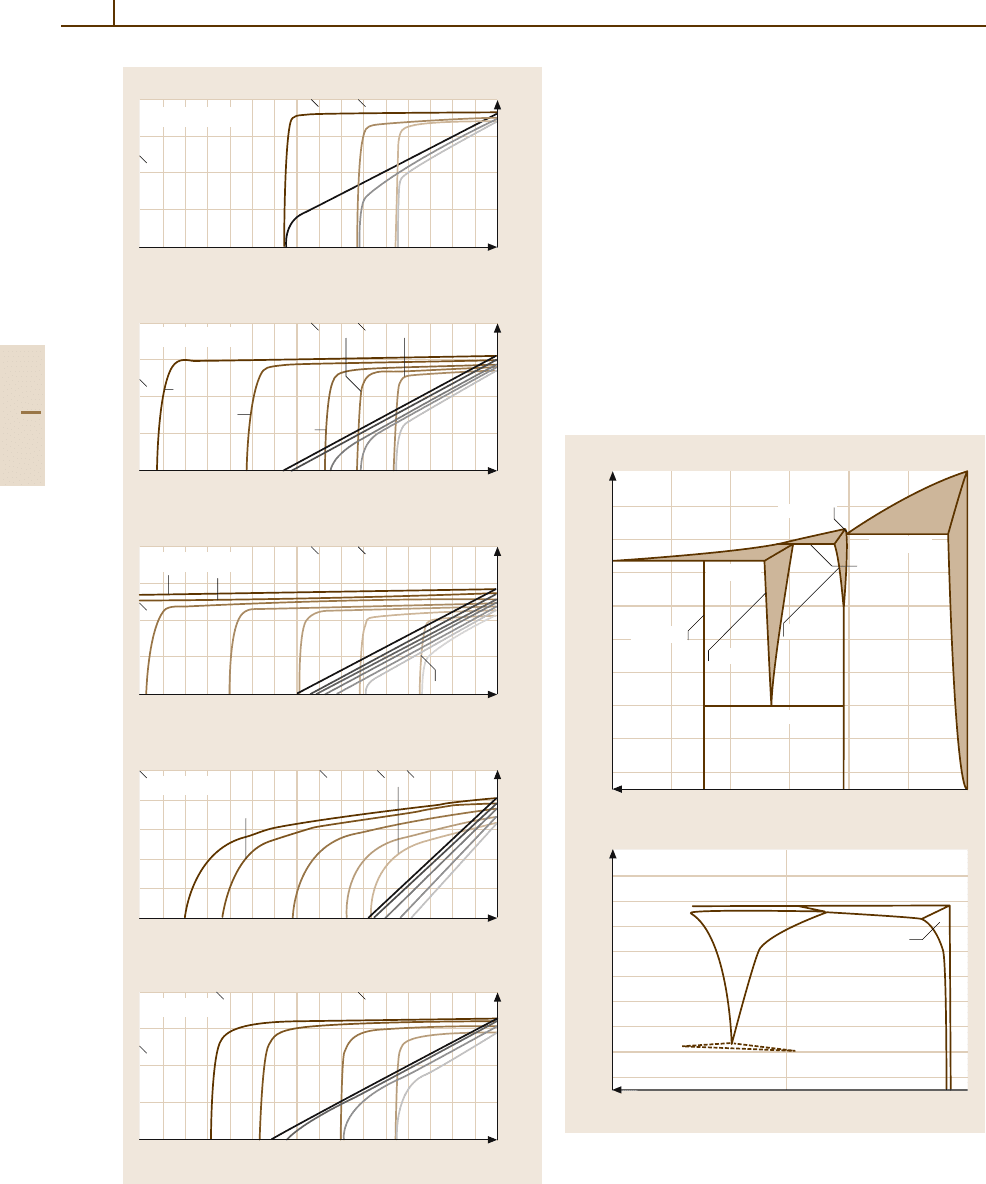
804 Part 4 Functional Materials
1.6
1.2
0.8
0.4
0
J, B (T)
H (kA m
–1
)
–1600 –1200 –800 –400 0
1 1.5 2
0.5
1.6
1.2
0.8
0.4
0
J, B (T)
H (kA m
–1
)
–1600 –1200 –800 –400 0
1 1.5 2
0.5
1.6
1.2
0.8
0.4
0
J, B (T)
H (kA m
–1
)
–1600 –1200 –800 –400 0
1 1.5 2
0.5
1
0.8
0.6
0.4
0.2
0
J, B (T)
H (kA m
–1
)
–1600 –1200 –800 –400 0
1 1.5 20.5
1.6
1.2
0.8
0.4
0
J, B (T)
H (kA m
–1
)
–1600 –1200 –800 –400 0
12
0.5
–B/H
Vacodym 722
20°C60°C
80°C
–B/H
Vacodym 633
60°C
100°C
120°C
150°C
–B/H
Vacodym 688
20°C
120°C
80°C
150°C 180°C 210°C
240°C
–B/H
MQ2 E15
25°C
50°C
100°C
150°C
175°C
–B/H
MQ3 F42
25°C
50°C
100°C
150 °C
a)
b)
c)
d)
e)
20°C
Fig. 4.3-63a–e Fe
14
Nd
2
B-based commercial magnets
[3.10].
(a) Top grade magnet with highest remanence B
r
.
Isostatically pressed, designed to meet exceptional re-
quirements for maximum energy density at operating
temperatures up to 60
◦
C. (b) Magnet, axially pressed, with
an optimum combination of high coercivity and energy
product
(c) Magnet, axially pressed, with a very high coer-
civity; exceptionally well suited for use in highly dynamic
servo motor applications.
(d) Isotropic dense magnet made
from rapidly quenched powder by means of the hot press-
ing technique.
(e) Magnet made from rapidly quenched
powder by means of the hot pressing and hot deforming
technique; especially well suited for complicated shaped
magnets, such as scewed arcs in special motor applications
1400
1300
1200
1100
1000
900
800
700
600
30 25 20 15 10 5 0
20 15 10
T(°C)
b)
Samarium (at.%)
a)
Sm
2
Co
7
800°C
1240°C
1290°C
1325°C
1340°C
SmCo
5
Sm
2
Co
17
T(°C)
Samarium (at.%)
1:5
2:17
730°C
Fig. 4.3-64 (a) Part of the Co
−
Sm phase diagram. (b) Sec-
tion of the Co
−
Sm
−
Cu phase diagram at 10 at.% Cu [3.10]
Part 4 3.3

Magnetic Materials 3.3 Hard Magnetic Alloys 805
Table 4.3-42 Co
5
RE alloys. Room temperature intrinsic magnetic properties, the crystal anisotropy constant K
1
,the
magnetic saturation M
s
, the anisotropy field H
a
= 2K
1
/M
s
, and the Curie temperature, T
c
[3.10]
RE
a
K
b
1
4πM
b
s
H
a
T
b
c
(10
7
erg cm
−3
) (T) (MA m
−1
) (K)
Ce 5.3(6) 0.83 13 660 (20)
Pr 8.1(9) 1.29 12.5 900 (10)
Nd 0.7(5) 1.34 1.1 910 (2)
Sm 17.2(9) 1.12 (3) 31 990 (10)
Gd 4.6(5) 0.35 (3) 26 1035
Tb NC 973
Dy NC 961
Ho 3.6(3) 0.52 13.8 996
Er 4.2(4) 0.4 14.6 983
La 5.9(5) 0.91 10.6 834
Y 5.2(4) 1.11 9.3 980
a
No data are available for the RE elements Tm, Yb, and Lu
b
The mean value is given where more than one reference is available; the number in parentheses indicates the standard deviation in
the last figure. NC: non-collinear spin structure
Table 4.3-43 Room temperature intrinsic magnetic properties, of Co
17
RE
2
alloys [3.10]
RE
a
K
b
1
4π M
b
s
H
a
T
b
c
(10
7
erg cm
−3
) (T) (MA m
−1
) (K)
Ce −0.6 1.15 1068 (10)
Pr −0.6 1.38 1160 (10)
Nd −1.1 1.39 1160 (3)
Sm 3.3(1) 1.25 (3) 5.3(1) 1196 (1)
Gd −0.5 0.73 1212 (6)
Tb −3.3(6) 0.67 1189 (4)
Dy −2.6(5) 0.69 1173 (8)
Ho −1.0(2) 0.85 1177 (1)
Er 0.41 (3) 1.05 (5) 0.75 1175 (15)
TM 0.50 (5) 1.21 0.83 1179 (2)
Yb −0.38 1.35 1180
Lu −0.20 (5) 1.41 1202 (6)
Y −0.34 (2) 1.27 1199 (13)
a
La does not form the 17/2 phase. The 17/2 phases with Sm, Er, and Tm show uniaxial anisotropy while all others have easy plane
anisotropy
b
The mean value is given where more than one reference is available; the number in parentheses indicates the standard deviation in
the last figure
Phase Equilibria of Co–RE Systems
The phase diagrams of Co
−
RE systems are very similar.
Figure 4.3-64 shows the magnetically relevant part of the
Co
−
Sm phase diagram. The features to note are: Co and
Co
17
Sm
2
form a eutectic, while Co
5
Sm forms as a result
of a peritectic reaction between Co
17
Sm
2
and liquid.
Both Co
5
Sm and Co
17
Sm
2
show a significant range of
homogeneity at elevated temperatures. The compound
Co
5
Sm is unstable at room temperature and decomposes
via an eutectoid reaction into Co
7
Sm
2
and Co
17
Sm
2
.
Iron and Cu are two important substitutional elem-
ents for Co
−
RE alloys with respect to manufacturing
Part 4 3.3

806 Part 4 Functional Materials
permanent magnets. In Co
5
RE compounds, Fe may sub-
stitute up to 5 at.% Co while complete solubility occurs
in (Co
1−x
Fe
x
)
17
RE
2
. Copper is essential in Co
17
Sm
2
type alloys. The different solubility of Cu in 5/1and
17/2 is used to form precipitates in the 17/2 phase,
resulting in a microstructure which provides high coer-
civity.
Co–Sm-Based Permanent Magnets
Powder Metallurgical Processing. Cobalt–Samarium
magnets are produced using powder metallurgical tech-
niques. Alloys are prepared by an inductive melting
process or a Ca reduction process. The starting alloys
are crushed and pulverized to single crystalline par-
ticles 3–4 µm in diameter. The powders are compacted
in a magnetic field to obtain anisotropic magnets: by
uniaxial compaction in magnetic fields, either parallel
or transverse to the direction of the applied force; or
by isostatic compaction of powders in elastic bags after
subjecting the filled bags to a pulsed field. The magnet-
Table 4.3-44 Co
5
Sm-based magnetic materials. Magnetic properties at room temperature, typical values [3.10]
B
r B
H
c J
H
c
(BH)
max
Press mode
a
Material Producer code
b
(T) (kA m
−1
) (kA m
−1
) (kJ m
−3
)
1.01 755 1500 200 Iso Co
5
Sm Vacomax 200
0.95 720 1800 180 TR Co
5
Sm Vacomax 170
1.0 775 2400 200 Iso Co
5
Sm Recoma 25
0.94 730 2400 175 TR Co
5
Sm Recoma 22
0.9 700 2400 160 A Co
5
Sm Recoma 20
0.73 570 >2400 105 A Co
5
Sm
0.8
Gd
0.2
EEC 1.5TC-13
0.61 480 >2400 70 A Co
5
Sm
06
Gd
0.4
EEC 1.5TC-9
a
Iso: isostatically pressed; TR: uniaxially pressed in transverse oriented aligning fields; A: uniaxially pressed in axially oriented aligning fields
b
Vacomax: Trademark of Vacuumschmelze GmbH, Germany; Recoma: Trademark of Ugimag AG, Switzerland; EEC: Trademark of EEC
Electron Energy Corporation, USA
Table 4.3-45 Physical properties of sintered Co
5
Sm magnets
a
[3.10]
Density Curie Electrical Specific Thermal Thermal expansion Young’s Flexural Com- Vickers
tempera- resistivity heat conduc- coefficient modulus strength pression Hard-
ture tivity strength ness
c axis ⊥ c axis
(g cm
−3
) (K) ( mm
2
m
−1
) (Jkg
−1
K
−1
) (Wm
−1
K
−1
) (10
−6
K
−1
) (10
−6
K
−1
) (kN mm
−2
) (N mm
−2
) (N mm
−2
)
8.40 (0.10) 990 (10) 0.53 (0.03) 372 (3) 11.5 (1.0) 6.0 (1.5) 12.5 (0.5) 150 (40) 125 (35) 900 (300) 580 (50)
a
All values for 300 K. Average values are taken from the companies brochures of: VAC Vacuumschmelze, Hanau, Germany; MS Magnetfabrik
Schramberg, Schramberg, Germany; Ugimag AG, Lupfig, Switzerland; EEC Electron Energy Corporation, Landisville, USA; TDK
Corporation, Tokyo Japan; Hitachi Metals Ltd, Tokyo, Japan. The numbers in parentheses indicate the standard deviation
ically aligned green compacts are sintered in an inert
atmosphere to achieve an optimum combination of high
density and high coercive field.
5/1 Type Magnets. Binary Co
5
Sm is the basis of 5/1
type magnets. Table 4.3-44 lists some of the magnetic
properties at room temperature and Table 4.3-45 lists the
physical properties of sintered Co
5
Sm magnets. Partial
substitution of Sm by Pr increases B
s
while still yield-
ing sufficiently high
J
H
c
. The microstructure of Co
5
Sm
magnets consists of single domain grains. Magnetization
reversal starts by nucleation of domains in a demagne-
tizing field. The domain wall moves easily through the
particle.
The application of permanent magnets in measuring
devices or in devices in aircraft or space systems re-
quires a small temperature coefficient (TC) of B
r
. The
combination of Co
5
Sm which has a negative TC, with
Co
5
Gd, which has a positive TC, yields magnets with
reduced temperature dependence of B
r
, reaching about
Part 4 3.3
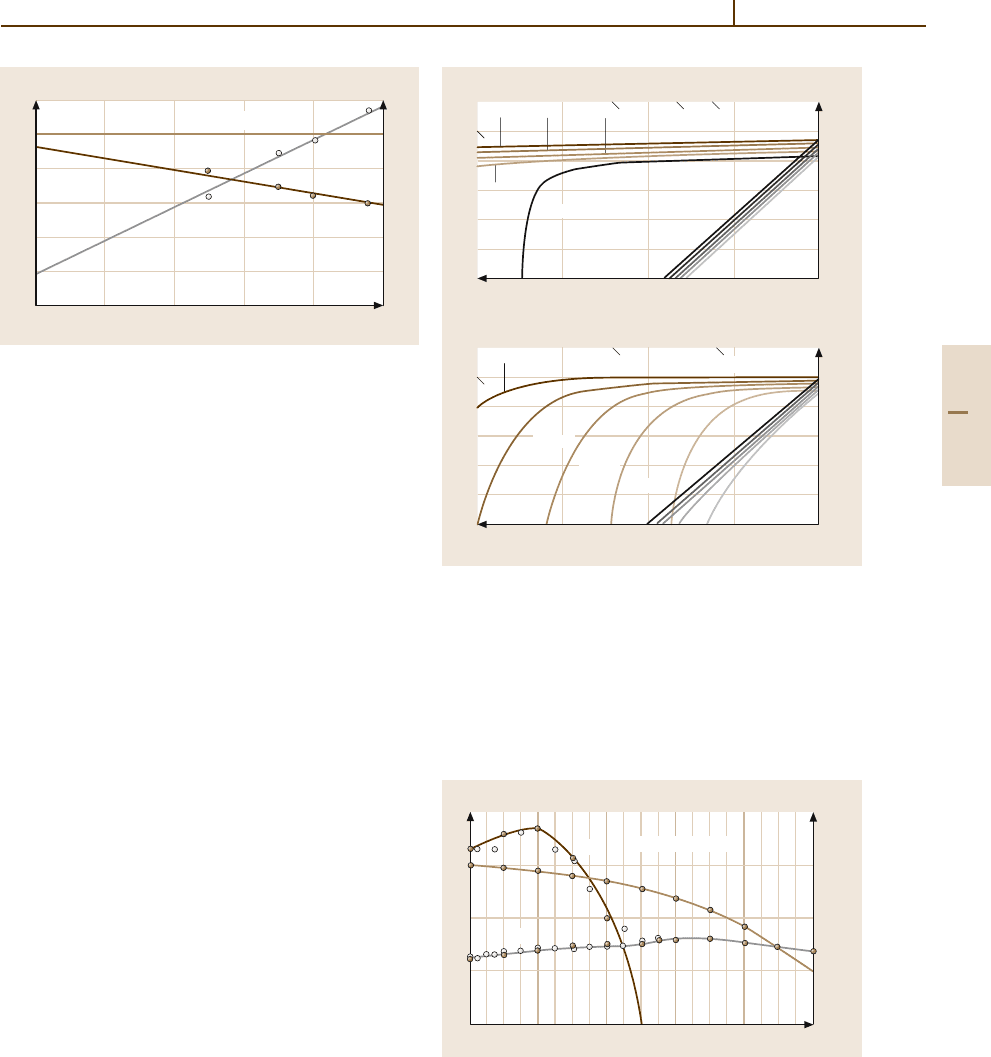
Magnetic Materials 3.3 Hard Magnetic Alloys 807
1.2
1
0.8
0.6
0.4
0.2
0
1
0
–1
–2
–3
–4
–5
0 0.1 0.2 0.3 0.4 0.5
Gd Content (x)
Br (T) TC (10
–4
K)
Tk
Br
Co
5
Sm
1–x
Gd
x
Fig. 4.3-65 Temperature coefficient TC of Co
5
Sm
1−x
Gd
x
magnets in the temperature range between 20 and 200
◦
C.
The coercivity of these ternary magnets is comparable to
that of binary Co
5
Sm magnets due to the high anisotropy
field of Co
5
Gd H
a
= 24 MA m
−1
while for Co
5
Sm, H
a
=
31 MA m
−1
[3.10]
zero for Co
5
Sm
0.6
Gd
0.4
between room temperature and
200
◦
C (Fig. 4.3-65).
Tables 4.3-44 and 4.3-45 list the magnetic proper-
ties of typical Co
5
Sm based magnets and their physical
properties, respectively. Figures 4.3-66a,b show charac-
teristic demagnetisation curves.
17/2 Type Magnets. The permanent magnetic po-
tential of the binary phase Co
17
Sm
2
is increased
by partially substituting Co by other transition met-
als. The general chemical composition of commercial
magnets corresponds to (Co
bal
Fe
v
Cu
y
Zr
x
)
z
Sm. Cop-
per is the essential addition. Its solubility in the
17/2 phase is strongly temperature-dependent, and
this is used for precipitation hardening of 17/2 mag-
nets.
The influence of Fe on the intrinsic magnetic prop-
erties is summarized in Fig. 4.3-67. Both Zr and Hf
increase coercivity. Figures 4.3-67a,b show the com-
bined effects of Fe, Cu, and Zr additions and the Co/Sm
ratio on the temperature dependence of coercivity
J
H
c
.
The magnets are sintered between 1200 and 1220
◦
C.
A single phase with Zn
17
Th
2
structure is obtained
by homogenization at temperatures between 1160 and
1190
◦
C. After rapid cooling the magnets are finally an-
nealed between 800 and 850
◦
C, followed by cooling
to 400
◦
C. The microstructure leading to high coerciv-
ity
J
H
c
consists of 17/2 matrix grains, a 5/1 boundary
phase enriched in Cu, and platelet-shaped precipitates
enriched in Fe and Zr. The coercivity of these magnets
1.2
1
0.8
0.6
0.4
0.2
0
J, B (T)
H (kA m
–1
)
–1600 –1200 –800 –400 0
0.5
1.2
1
0.8
0.6
0.4
0.2
0
J, B (T)
H (kA m
–1
)
0.5
–1600 –1200 –800 –400 0
–B/H = 1
a)
1.5 2
–B/H = 1
b)
2
Recoma 22
150°C100°C
20°C
200°C
250°C
Vacomax 200
20°C
100°C
150°C
200°C
250°C
Fig. 4.3-66a,b Co
5
Sm magnets. Demagnetization curves
of typical commercially available magnets [3.10].
(a) Mag-
net with high intrinsic coercivity
J
H
c
up to 300
◦
C,
uniaxially pressed in a transverse aligning field; Re-
coma: trademark of Ugimag AG, Switzerland.
(b) Magnet
with highest energy density obtained by cutting from
isostatically pressed block; Vacomax: trademark of Vac-
uumschmelze GmbH, Germany
1600
1200
800
400
0
4
3
2
1
0
0.2
0.4
0.6
0.8
1
0
4 πM
s
, K
1
(T) (10
2
erg cm
–3
)
x
T
c
(K)
K
1
T
c
M
s
(Co
1–x
Fe
x
)
17
Sm
2
Fig. 4.3-67 (Co
1−x
Fe
x
)
17
Sm
2
. Dependence K
1
,4πM
s
,
and T
c
on the Fe content x [3.10]
is based on pinning of the Bloch walls at the 5/1 grain
boundary phase.
Part 4 3.3

808 Part 4 Functional Materials
Table 4.3-46 Chemical composition of commercial high energy 17/2 magnets [3.10]
Element Sm
a
Co Cu Fe Zr
wt% 25–27 balance 4.5–8 14–20 1.5–3
a
The Sm content includes the fraction of Sm which is present as Sm
2
O
3
, typically 2.5wt%
Table 4.3-47 Annealing treatments for 17/2 type magnets [3.10]
Isothermal ageing Cooling rate to 400
◦
C
J
H
c
Magnetizing field H
m
(kA m
−1
) (kA m
−1
)
high
J
H
c
850
◦
C/10 hours 1K/min > 2000 5000
low
J
H
c
800
◦
C/30 min. 5K/min 500–800 1500
Table 4.3-48 High energy TM
17
Sm
2
magnets for applications up to 300
◦
C, typical values [3.10]
B
r B
H
c J
H
c
(BH)
max
Press mode
a
Material Producer code
b
(T) (kA m
−1
) (kA m
−1
) (kJ m
−3
)
1.14 670 800 247 Iso TM
17
Sm
2
Hicorex -30CH
1.12 730 800 240 Iso TM
17
Sm
2
Vacomax 240HR
1.05 720 800 210 A TM
17
Sm
2
Vacomax 240
1.10 820 2070 225 Iso TM
17
Sm
2
Vacomax 225HR
1.07 800 2000 215 TR TM
17
Sm
2
Recoma 28
1.04 760 2070 205 A TM
17
Sm
2
Vacomax 225
0.9 654 > 2000 150 A TM
17
(Sm
0.8
, Gd
0.2
)
2
EEC2:17TC-18
0.8 575 > 2000 115 A TM
17
(Sm
0.6
, Gd
0.4
)
2
EEC2:17TC-15
a
Iso: isostatically pressed; TR: uniaxially pressed in transverse oriented aligning fields; A: uniaxially pressed in parallel oriented aligning
fields
b
Hicorex: Trademark of Hitachi Metals Ltd., Japan; Vacomax: Trademark of Vacuumschmelze GmbH, Germany; Recoma: Trademark of
Ugimag AG, Switzerland; EEC: Trademark of EEC Electron Energy Corporation, USA
Table 4.3-49 Composition of 17/2 magnets for operating up to 550
◦
C [3.10]
Element Sm Co Cu Fe Zr
wt% 26.5–29 balance 6–12 7 2.5–6
Table 4.3-50 Physical properties of sintered TM
17
Sm
2
magnets
a
[3.10]
Density Curie Electrical Specific Thermal Thermal expansion Young’s Flexural Com- Vickers
temp- resistivity heat conduc- coefficient modulus strength pression hard-
erature tivity strength ness
-c axis ⊥-c axis
(g cm
−3
) (K) ( mm
2
m
−1
) (Jkg
−1
K
−1
) (Wm
−1
K
−1
) (10
−6
K
−1
) (10
−6
K
−1
) (kN mm
−2
) (kN mm
−2
) (kN mm
−2
)
8.38 (0.08) 1079 (8) 0.86 (0.05) 355 (30) 10.5 (1.5) 8.4(1) 11.5 (0.5) 160 ( 40) 130 (15) 760 (150) 600 (50)
a
All values are for 300 K. The values are the average of values taken from company brochures
Part 4 3.3
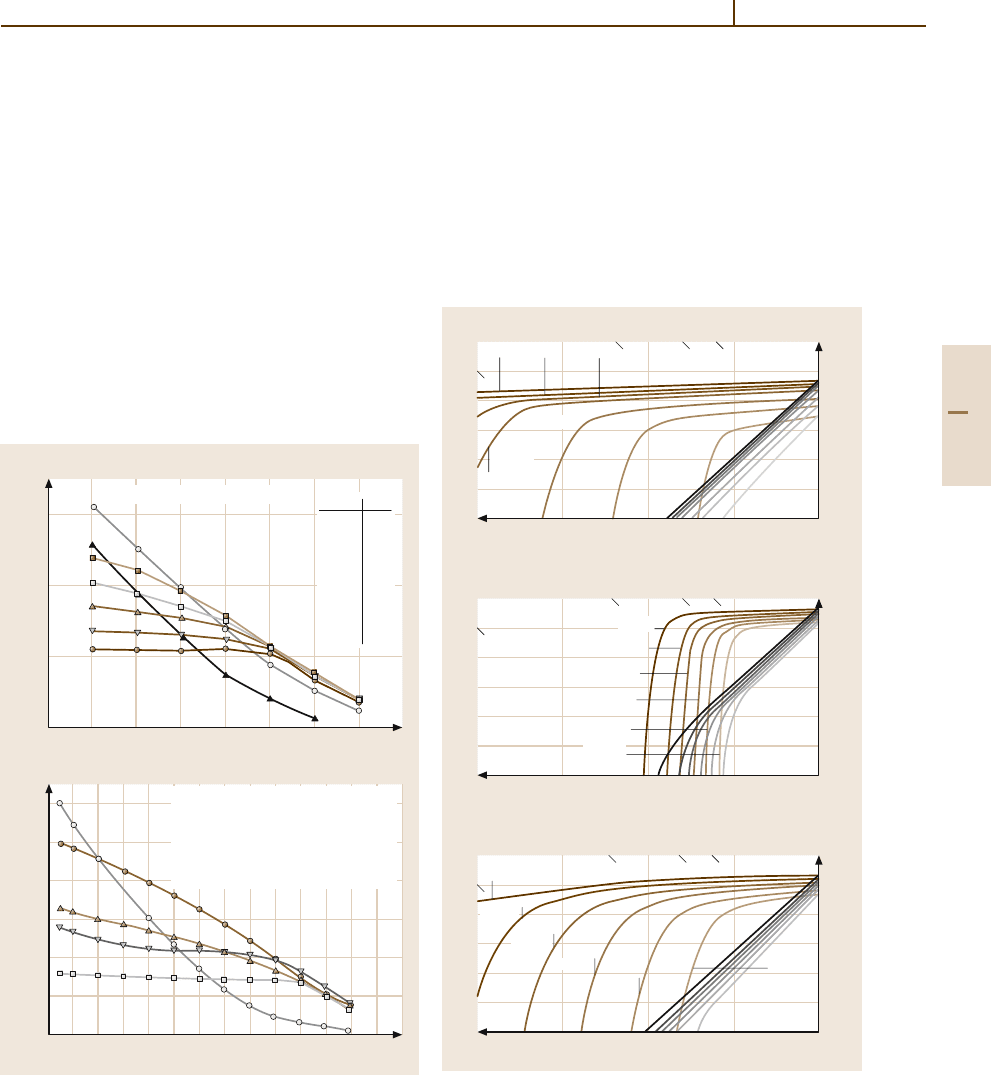
Magnetic Materials 3.3 Hard Magnetic Alloys 809
High Energy Magnets for Applications at Tempera-
tures up to 300
◦
C. The compositional parameters v, y,
x,andz of the 17/2 type magnets are normally opti-
mized for highest (BH)
max
between room temperature
and 300
◦
C. The range of chemical compositions of these
high energy magnets is given in Table 4.3-46.
Tables 4.3-48 and 4.3-50 list the magnetic proper-
ties of typical Co
17
Sm
2
based magnets and their physical
properties, respectively. Figures 4.3-69a–c show charac-
teristic demagnetization curves.
Two modifications of 17/2 magnets can be obtained
from identical chemical compositions according to the
annealing treatment applied (see Table 4.3-47). 17/2
magnets with reduced TC of B
r
are obtained by sub-
stituting part of Sm by Gd. Table 4.3-45 shows some
1400
1000
600
200
250 350 450 550 650
6
7
5
4
3
2
1
2400
2000
1600
1200
800
400
0
0 100 200 300 400 500 600 700
1
2
3
4
5
T(°C)
a)
J
H
c
(kA m
–1
)
z
1
2
3
4
5
6
7
7.14
7.26
7.38
7.50
7.62
7.86
8.10
(Co
bal
Fe
0.09
Cu
0.09
Zr
0.025
)
z
Sm
Curve
b)
J
H
c
(kA m
–1
)
T(°C)
1
2
3
4
5
Typical high energy 17/2 magnet
(Co
bal
Fe
0.09
Cu
0.09
Zr
0.03
)
7.69
Sm
(Co
bal
Fe
0.09
Cu
0.08
Zr
0.025
)
7.69
Sm
(Co
bal
Fe
0.04
Cu
0.10
Zr
0.03
)
7.38
Sm
(C
obal
Fe
0.09
Cu
0.09
Zr
0.025
)
7.14
Sm
Fig. 4.3-68a,b Temperature dependence of
J
H
c
for
(Co
bal
Fe
v
Cu
y
Zr
x
)
z
as varied by the concentration of the
substitutional elements and of Sm [3.10]
(a) Dependence
on the TM/Sm ratio;
(b) Dependence on other variations in
chemical composition
typical values of the magnetic properties of high energy
TM
17
Sm
2
magnets.
Magnets for High Temperature Applications. Special
applications in aircraft and spacecraft require mag-
nets with linear demagnetization curves up to 550
◦
C.
Suitable high temperature magnets are obtained by in-
creasing Sm and Cu and decreasing Fe. Data are given
in Table 4.3-49 and Fig. 4.3-69a.
1.2
1
0.8
0.6
0.4
0.2
0
J, B (T)
H (kA m
–1
)
–1600 –1200 –800 –400 0
0.5
1.2
1
0.8
0.6
0.4
0.2
0
J, B (T)
H (kA m
–1
)
–1600 –1200 –800 –400 0
0.5
1.2
1
0.8
0.6
0.4
0.2
0
J, B (T)
H (kA m
–1
)
–1600 –1200 –800 –400 0
0.5
–B/H = 1
a)
1.5 2
150°C100°C25°C
200°C
300°C
400°C
500°C
–B/H = 1
b)
1.5 2
150°C
100°C
20°C
200°C
250°C
300°C
Vacomax 240
–B/H = 1
c)
1.5 2
20°C
200°C
150°C
250°C
300°C
Recoma 28
100°C
Fig. 4.3-69a–c TM
17
Sm
2
magnets. Demagnetization
curves [3.10]
(a) Magnet may be used up to 500
◦
C. Coat-
ing is needed for protection against oxidation > 300
◦
C.
(b) Low coercivity, easy-to-magnetize magnet. (c) High
energy, high coercivity magnet
Part 4 3.3
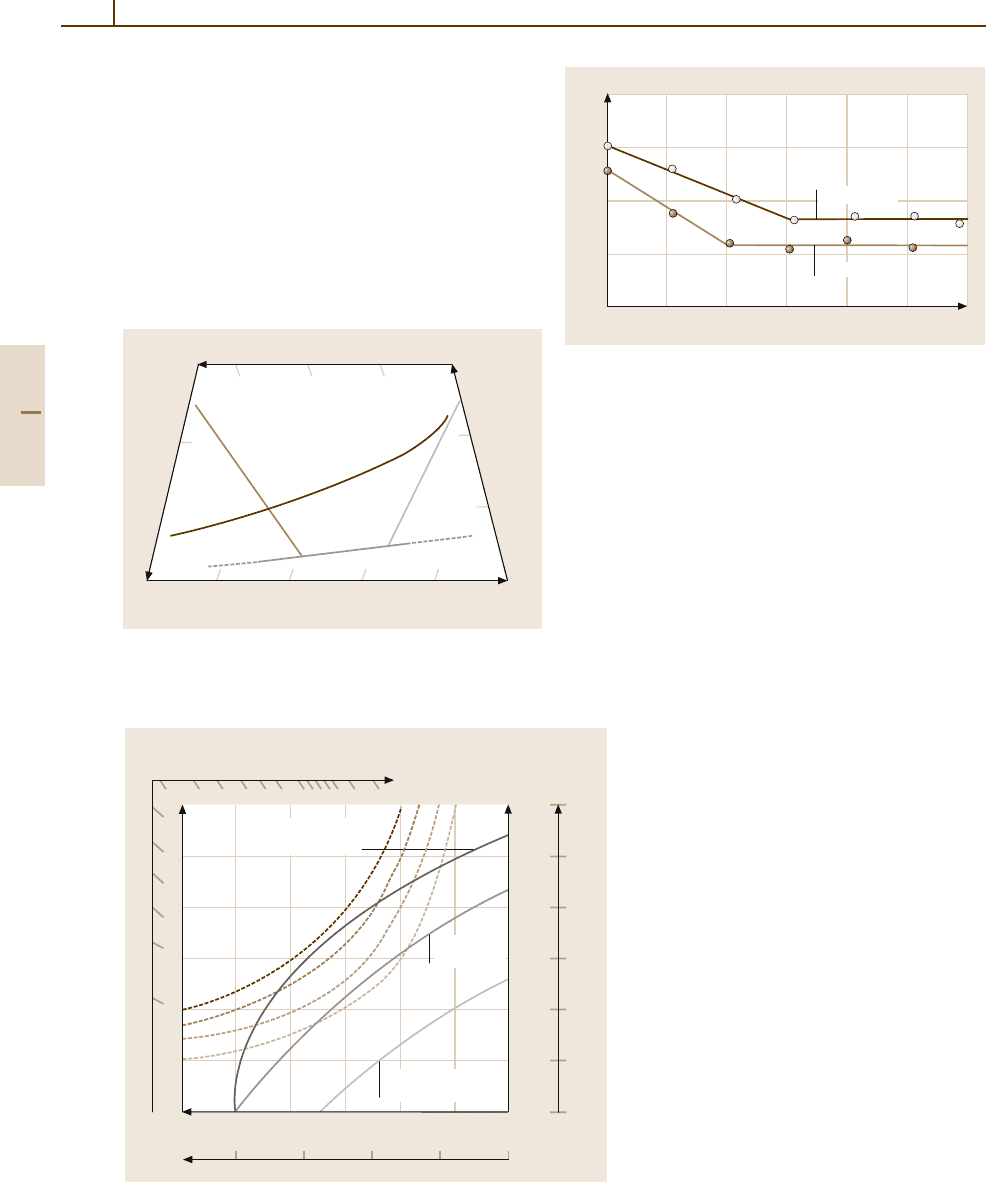
810 Part 4 Functional Materials
4.3.3.6 Mn–Al–C
In the binary Mn
−
Al system the ferromagnetic,
metastable τ -Mn
−
Al phase containing 55 wt% Mn is
obained by annealing at 923 K, or by controlled cooling
of the stable ε phase from ≥ 1073 K. The τ phase has
a high magnetocrystalline anisotropy K
1
∼
=
10
6
Jm
−3
and I
s
= 0.6 T. The magnetic easy axis is the c axis.
The τ phase can be stabilized by adding 0.5wt%C.
Hot deformation at about 973 K permits formation of
30 28 26
32
3
2
1
0
66 68 70 72 74 76
Mn (wt%)
C
(wt%)
Al
(wt%)
τ
+Mn
3
AlC+Al
4
C
3
τ
+Mn
3
AlC
τ
+
γ
+Mn
3
AlC
τ
+
β
τ
+
γ
β
+
Fig. 4.3-70 Schematic representation of the phase rela-
tions of Mn
−
Al
−
C at 873 K [3.10]
600
500
400
300
200
100
0
200 150 100 50 0
0.5
1
2
345
6
5
4
3
2
1
3 2.5 2 1.5 1 0.5 0
Permeance
Coefficient, G (Oe)
Magnetic Flux
Density, B
Strength of Magnetic Field, H
(kOe)
(kA m
–1
)
(kG)
(BH)max. MGOe
6543
Plane
Anisotropy
Axial Anisotropy
(Radial Direction)
Axial Anisotropy
(Axial Direction)
(mT)
Fig. 4.3-72 Magnetic properties of an extruded
Mn
−
Al
−
C magnet [3.10]
700
650
600
550
500
0.0 0.2 0.4 0.6 0.8 1.0 1.2
T
c
(K)
C (wt%)
72 wt% Mn
70 wt% Mn
Fig. 4.3-71 Dependence of Curie temperature of τ-
Mn
−
Al
−
C on the carbon concentration [3.10]
anisotropic magnets. Figure 4.3-70 shows schematically
the 873 K isotherm of the Mn
−
Al
−
C phase diagram.
Carbides coexist with the metallic ferromagnetic
phases. This is unfavorable for the mechanical proper-
ties. The Curie temperature of the τ phase decreases with
increasing C content to a constant value (see Fig. 4.3-71)
according to the phase diagram.
An alternative process to form τ-Mn
−
Al
−
Cmag-
nets is to use gas-atomized powder which is canned
Part 4 3.3
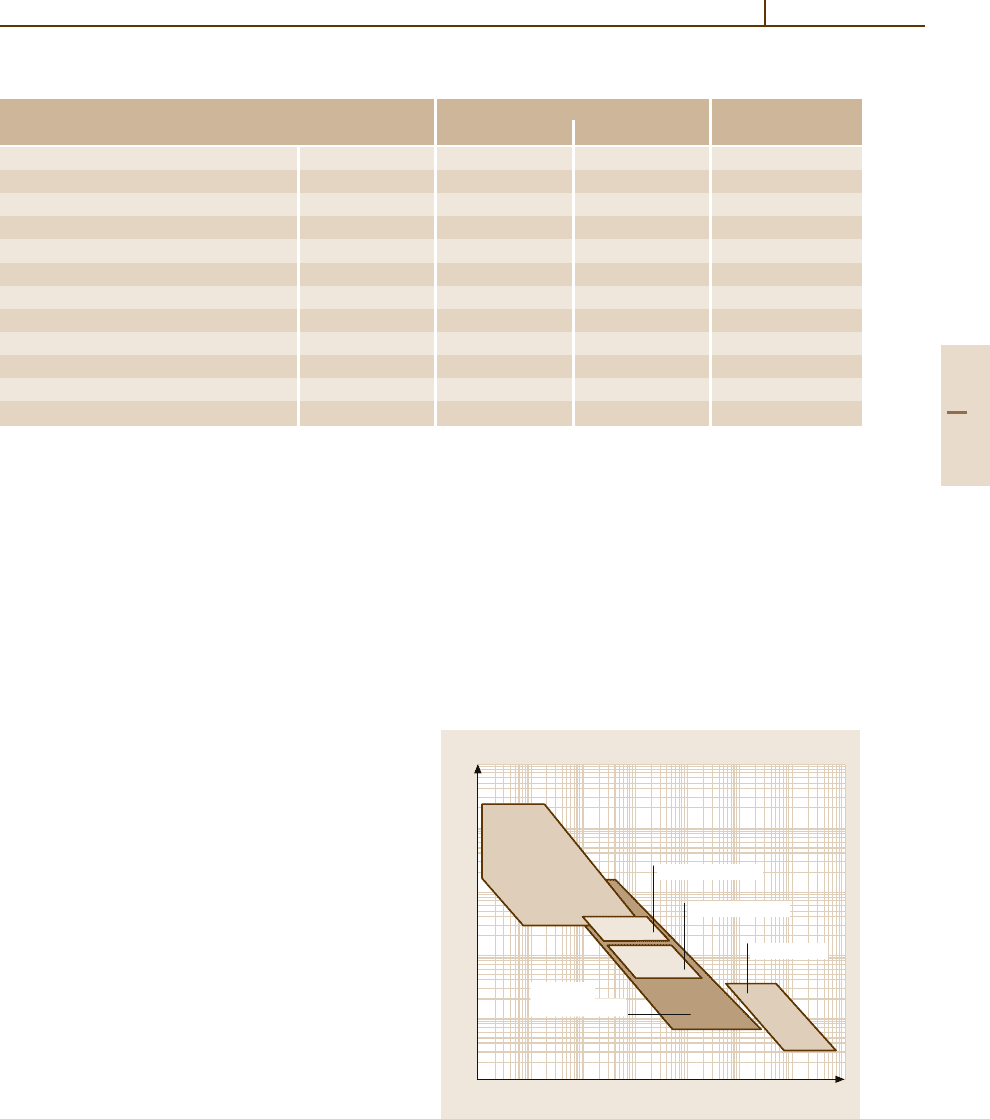
Magnetic Materials 3.4 Magnetic Oxides 811
Table 4.3-51 Properties of a Mn
−
Al
−
C magnet [3.10]
Axial Anisotropy Plane anisotropy
Axial direction Radial direction
Maximum energy product (BH)
max
(kJ m
−3
) 44 10 28
Residual magnetic flux density B
r
(mT) 550 270 440
Coercivity H
c
(kA m
−1
) 200 144 200
Optimum permeance coefficient (µHm
−1
) 1.9 1.9 1.9
Average reversal permeability (µHm
−1
) 1.4 ∼ 1.6 1.4 ∼ 1.6 1.4 ∼ 1.6
Temperature coefficient of B
r
(% K
−1
) −0.11 −0.11 −0.11
Curie point T
c
(K) 573 573 573
Maximum operating temperature (K) 773 773 773
Density (kg m
−3
) 5100 5100 5100
Hardness (HR
c
) 49 ∼ 56 49 ∼ 56 49 ∼ 56
Tensile strength R
m
(N m
−2
) > 290 ×10
6
> 290 × 10
6
> 290 × 10
6
Compression strength (N m
−2
) > 2000 ×10
6
> 2000 × 10
6
> 2000 × 10
6
and extruded at 973 K. By atomizing, the powder is
rapidly quenched and consists of the high temperature
ε phase. During hot extrusion it transforms to the axi-
ally anisotropic τ phase. Repeated die pressing results
in plane anisotropy. The magnetic properties are shown
in Fig. 4.3-72 and listed in Table 4.3-51.
4.3.4 Magnetic Oxides
The magnetic properties of oxides and related com-
pounds have been tabulated in comprehensive data
collections [3.4]. A review of the basic magnetic prop-
erties of garnets {A
3
}[B
2
](Si
3
)O
12
and spinel ferrites
MeOFe
2
O
3
or Me
II
Fe
III
2
O
4
is given by Guillot in
[3.3].
4.3.4.1 Soft Magnetic Ferrites
Both MnZn and NiZn ferrites are the common desig-
nations of the two main groups of soft magnetic oxide
materials. A more extensive account is given in [3.10].
The chemical formula of MnZn and NiZn ferrites is
M
2+
Fe
2
O
4
and they have spinel structures. The divalent
ions (M
2+
) are elements such as Mn, Fe, Co, Ni, Cu,
Mg, Zn, and Cd. They are located at tetrahedral or octa-
hedral sites of the spinel structures. Ceramic processing
methods are applied to produce the magnetic parts such
as ring-shaped cores for inductive components.
The use of different types of MnZn and NiZn fer-
rite materials varies with the operating frequency in the
application concerned. Figure 4.3-73 and Table 4.3-52
indicate the typical ranges of use and the mag-
netic properties of characteristic materials. Typically,
MnZn ferrites are used in the range of several MHz.
Table 4.3-53 lists the major applications with the perti-
nent operating frequencies. Since a phase shift occurs in
an ac-excited magnetic field, the permeability µ is ex-
pressed as a complex number, µ
−iµ
. The imaginary
10
5
10
4
10
3
10
2
10
1
10
0
10
–3
10
–2
10
–1
10
0
10
1
10
2
10
3
10
4
Complex permeability
Frequency (MHz)
MnMgZn ferrite
MgCuZn ferrite
Ferroxplana
NiZn and
NiCuZn ferrite
MnZn ferrite
Fig. 4.3-73 Relationships between frequency and complex
permeability of groups of characteristic soft magnetic fer-
rites [3.10]
Part 4 3.4
